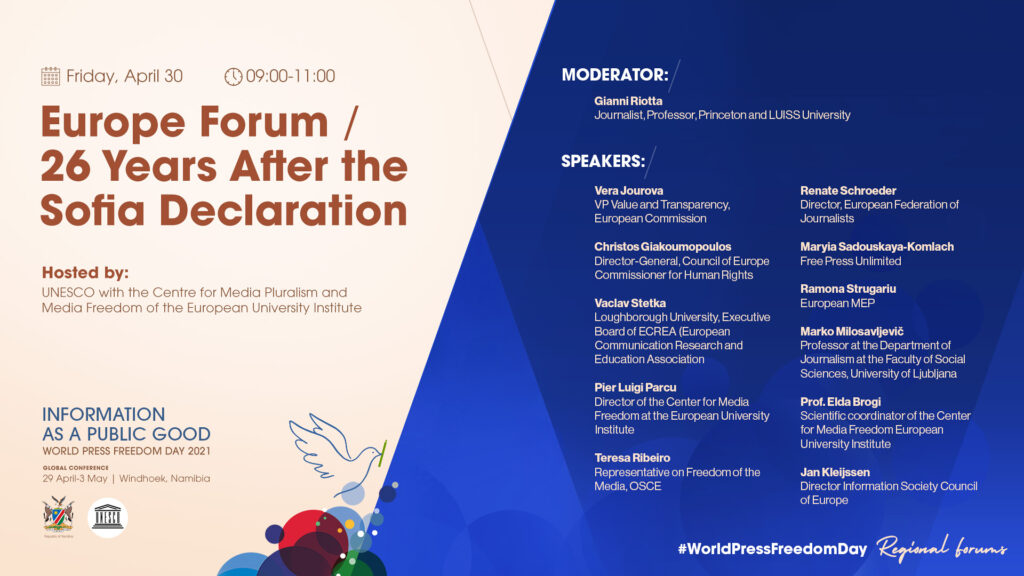
*The following text is from an intervention given by Vaclav Štětka at the UNESCO World Press Freedom Day Regional Forum for Europe on 29 April 2021.
Good morning, and thank you to the organisers for the opportunity to contribute to this highly timely forum on such an important occasion of the upcoming World Press Freedom Day. In my short intervention, I would like to bring in / emphasize the perspective from Central and Eastern Europe on some of these issues, not only because I come from the region myself and I study it as part of our project at Loughborough called The Illiberal Turn, but mainly because I believe that in these debates on digital platforms, misinformation and media literacy, the view from this region is often missing or it is underrepresented.
Disinformation is, of course, a huge problem in this region, as has been demonstrated probably most visibly during the pandemic, when various polls showed high prevalence of conspiracy beliefs about the Coronavirus, as well as high vaccine hesitancy among citizens of Central and Eastern Europe, at least initially – hesitancy that has been at least partially supported by exposure to disinformation, as a number of empirical studies from other countries have documented. For example according to the survey by Globsec in Autumn last year in 10 countries of the region, on average a third of citizens believed that Covid-19 is a hoax to manipulate the population, and every fourth respondent believed the conspiracy theory about nano-chips in the vaccines.[1] These are arguably significant and worrying numbers that demonstrate vulnerability of Central and Eastern European information spaces towards the kind of targeted disinformation campaigns, many of which are of course being linked to Russia.
However, in order to find instruments and design efficient policies to help protect us from these new digital threats on a pan-European level, we need to first recognize that there are some important differences between some countries and regions of Europe in the key elements of their respective disinformation ecosystems. Specifically, while in Western Europe and Western democracies in general the focus is primarily on social media and conspiracy websites that serve as key channels for disinformation, in Central and Eastern Europe, these channels are often complemented or even eclipsed in their importance and reach by mainstream media, including those that are state sponsored and government controlled.
This is very much the case for example in Hungary, where especially the state broadcaster is infamous for serving as a propaganda outlet for the government which uses it to spread disinformation and conspiracy stories about topics such as immigration, LGBT community, and most of all about George Soros. We know from our project “The Illiberal Turn” (https://www.illiberal-turn.eu/) that more than a third of Hungarians have an unfavourable opinion about Soros, and a large majority of those people are heavy consumers of state television; while those who get their news primarily from digital and social media tend to have a favourable opinion about him. We see a similar pattern in our data from Poland, where consumers of state television are overwhelmingly supportive of probably the most popular Polish conspiracy theory, about the Smolensk plane crash in 2010 – a conspiracy that the state television itself continues to perpetuate, even today[2] – while digital media consumers are mostly sceptical about it.[3]
In other words, if policy approaches aimed at fighting disinformation are mainly preoccupied with global digital platforms, they will be missing much of the broader picture and ultimately fail to deliver the desired outcomes in those parts of Europe that have been affected by rising authoritarianism and decline of media freedom, where both mainstream media and government actors are among the chief disseminators of disinformation.
I believe the upcoming World Press Freedom Day is the best opportunity to advocate for an argument that the fight against disinformation is indispensable from the effort to protect and support independent media and professional journalism. These two must go hand-in-hand, especially in countries where significant part of the mainstream media scene has been captured by the government or oligarchs.
This is certainly not to argue against the regulation of platforms per se. The evidence that free-flow of disinformation via digital platforms is detrimental for democracy is overwhelming, and so is the evidence that their business model is hurting professional journalism. But in designing policies to bring them under democratic control, we should be careful not throw the baby out with the bathwater, so to say. The key word here is “democratic” – and if we cannot guarantee that the control will indeed be a democratic one, there is a risk that such policies could do more harm than good, especially in the hands of increasingly illiberal governments that have already shown a great appetite for restricting media freedom and civic liberties under the guise of the pandemic.
Vaclav Štětka is Senior Lecturer in Communication and Media Studies at Loughborough University
[1] https://www.globsec.org/wp-content/uploads/2020/12/GLOBSEC-Trends-2020_read-version.pdf
[2] https://polandin.com/53211458/tvp-reveals-another-recording-of-donald-tusk-discussing-smolensk-air-disaster
[3] These are results of regression analysis, controlled for age and education.
